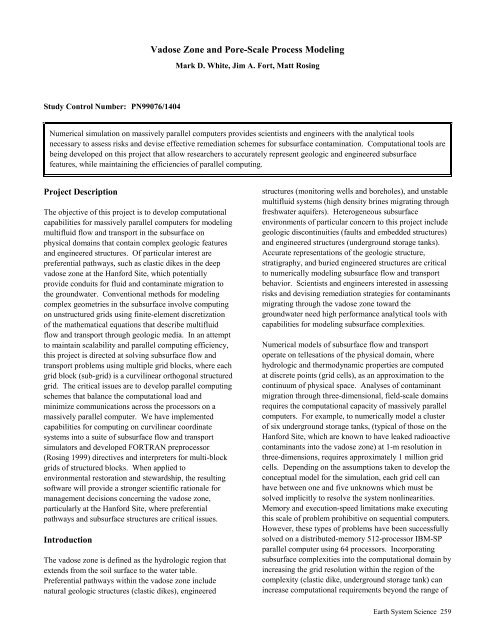PNNL-13501 - Pacific Northwest National Laboratory
PNNL-13501 - Pacific Northwest National Laboratory
PNNL-13501 - Pacific Northwest National Laboratory
You also want an ePaper? Increase the reach of your titles
YUMPU automatically turns print PDFs into web optimized ePapers that Google loves.
Study Control Number: PN99076/1404<br />
Vadose Zone and Pore-Scale Process Modeling<br />
Mark D. White, Jim A. Fort, Matt Rosing<br />
Numerical simulation on massively parallel computers provides scientists and engineers with the analytical tools<br />
necessary to assess risks and devise effective remediation schemes for subsurface contamination. Computational tools are<br />
being developed on this project that allow researchers to accurately represent geologic and engineered subsurface<br />
features, while maintaining the efficiencies of parallel computing.<br />
Project Description<br />
The objective of this project is to develop computational<br />
capabilities for massively parallel computers for modeling<br />
multifluid flow and transport in the subsurface on<br />
physical domains that contain complex geologic features<br />
and engineered structures. Of particular interest are<br />
preferential pathways, such as clastic dikes in the deep<br />
vadose zone at the Hanford Site, which potentially<br />
provide conduits for fluid and contaminate migration to<br />
the groundwater. Conventional methods for modeling<br />
complex geometries in the subsurface involve computing<br />
on unstructured grids using finite-element discretization<br />
of the mathematical equations that describe multifluid<br />
flow and transport through geologic media. In an attempt<br />
to maintain scalability and parallel computing efficiency,<br />
this project is directed at solving subsurface flow and<br />
transport problems using multiple grid blocks, where each<br />
grid block (sub-grid) is a curvilinear orthogonal structured<br />
grid. The critical issues are to develop parallel computing<br />
schemes that balance the computational load and<br />
minimize communications across the processors on a<br />
massively parallel computer. We have implemented<br />
capabilities for computing on curvilinear coordinate<br />
systems into a suite of subsurface flow and transport<br />
simulators and developed FORTRAN preprocessor<br />
(Rosing 1999) directives and interpreters for multi-block<br />
grids of structured blocks. When applied to<br />
environmental restoration and stewardship, the resulting<br />
software will provide a stronger scientific rationale for<br />
management decisions concerning the vadose zone,<br />
particularly at the Hanford Site, where preferential<br />
pathways and subsurface structures are critical issues.<br />
Introduction<br />
The vadose zone is defined as the hydrologic region that<br />
extends from the soil surface to the water table.<br />
Preferential pathways within the vadose zone include<br />
natural geologic structures (clastic dikes), engineered<br />
structures (monitoring wells and boreholes), and unstable<br />
multifluid systems (high density brines migrating through<br />
freshwater aquifers). Heterogeneous subsurface<br />
environments of particular concern to this project include<br />
geologic discontinuities (faults and embedded structures)<br />
and engineered structures (underground storage tanks).<br />
Accurate representations of the geologic structure,<br />
stratigraphy, and buried engineered structures are critical<br />
to numerically modeling subsurface flow and transport<br />
behavior. Scientists and engineers interested in assessing<br />
risks and devising remediation strategies for contaminants<br />
migrating through the vadose zone toward the<br />
groundwater need high performance analytical tools with<br />
capabilities for modeling subsurface complexities.<br />
Numerical models of subsurface flow and transport<br />
operate on tellesations of the physical domain, where<br />
hydrologic and thermodynamic properties are computed<br />
at discrete points (grid cells), as an approximation to the<br />
continuum of physical space. Analyses of contaminant<br />
migration through three-dimensional, field-scale domains<br />
requires the computational capacity of massively parallel<br />
computers. For example, to numerically model a cluster<br />
of six underground storage tanks, (typical of those on the<br />
Hanford Site, which are known to have leaked radioactive<br />
contaminants into the vadose zone) at 1-m resolution in<br />
three-dimensions, requires approximately 1 million grid<br />
cells. Depending on the assumptions taken to develop the<br />
conceptual model for the simulation, each grid cell can<br />
have between one and five unknowns which must be<br />
solved implicitly to resolve the system nonlinearities.<br />
Memory and execution-speed limitations make executing<br />
this scale of problem prohibitive on sequential computers.<br />
However, these types of problems have been successfully<br />
solved on a distributed-memory 512-processor IBM-SP<br />
parallel computer using 64 processors. Incorporating<br />
subsurface complexities into the computational domain by<br />
increasing the grid resolution within the region of the<br />
complexity (clastic dike, underground storage tank) can<br />
increase computational requirements beyond the range of<br />
Earth System Science 259

















